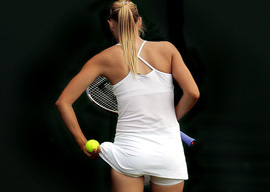
June 02, 2011

Maria Sharapova
They have no such limitations in other fields. Female musicians and singers aren’t technically inferior to their male colleagues. Nor are women artists. Nor are women writers. Nor, closer to our subject, are women runners, jumpers, or cyclists. So what brings out the worst in female tennis pros?
It’s not only technique: Unlike women in other sports, most female tennis players don’t have the conditioning of professional athletes. In a recent comparative survey of different sports, male tennis players were among the fittest athletes, while the women among the least fit. In other words, most female tennis players don’t work hard enough on their game’s technical or physical aspects.
Richard Krajicek, 1996 Wimbledon winner, once ungraciously said that “75 percent of the top 100 women are fat pigs.” A gentleman doesn’t talk about ladies that way, but many female players have physiques that more naturally belong in GQ than Tennis World. A few years ago GQ ran nude shots of two top players, having paid a seven-digit fee for the dubious privilege. And Caroline Wozniacki’s scantily clad, overfed body can be ogled on countless websites, including her own. (I’ve conducted the research personally—strictly for professional reasons, you understand.)
Perhaps this hints at the problem: Female players who look good in or out of clothes can have lucrative careers without having to hit tennis balls all that well. Take, for example, one blonde girl, long since retired, who never won a WTA tournament. In her only meaningful contribution to Grand Slams she once decided an Australian Open’s final by having entertained one of the participants throughout the night before, rendering him barely able to walk. Even though her on-court athleticism and creativity were nowhere near the same standard as Wozniacki’s, the girl has made millions modeling clothes, doing TV shows and commercials, and posing for the kind of pictures that got photographers arrested a generation ago. Following in her footsteps, Sharapova has amassed a reputed $90-million fortune, though less than $15 million of that was won on the tennis court. (Racquets don’t feature prominently in her alluring Google Images.)
While men pros concentrate on their job, women let outside interests take over. Practice courts, gyms, and running tracks are no competition for catwalks and studios. Many, including the Williams sisters, stop playing full-time. Some, like our blonde vixen of Aussie Open fame, stop playing altogether. There’s no need.
There is no justification for women getting equal prize money. And the commercial argument doesn’t work, either. Men play best-of-five matches, while the ladies only go best-of-three. Statistically, men’s matches are twice as likely to go to four sets as women’s to three, and many go to five. If men play twice as long, pro rata they get paid half as much.
The longer men’s matches also mean more commercial breaks and bigger TV revenues. And it’s not only the number of minutes, it’s also the ratings. If one channel were showing a match between Nadal and Federer (#1 and #3 in the world) and another between Wozniacki and Zvonareva (ditto), which one would you watch? Thought so. So would millions of others.
Ultimately, neither sporting nor commercial considerations led to equal prize money for women. It resulted from a sustained political campaign started by Billie Jean King in 1973, when the Women’s Tennis Association was founded specifically for this purpose. The campaign then gathered speed. Although the US Open surrendered that very year, Wimbledon and the French didn’t succumb until 2007. But in the end injustice prevailed. Whenever this happens, we are all the poorer for it.